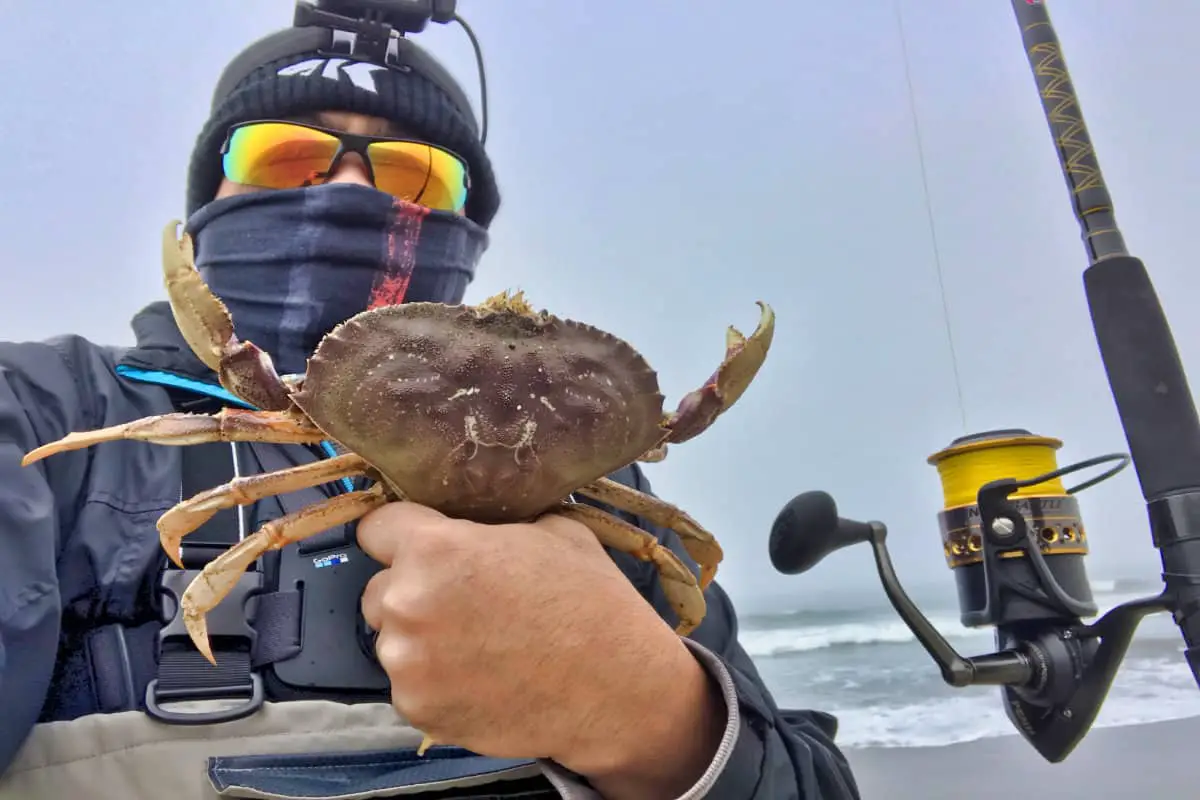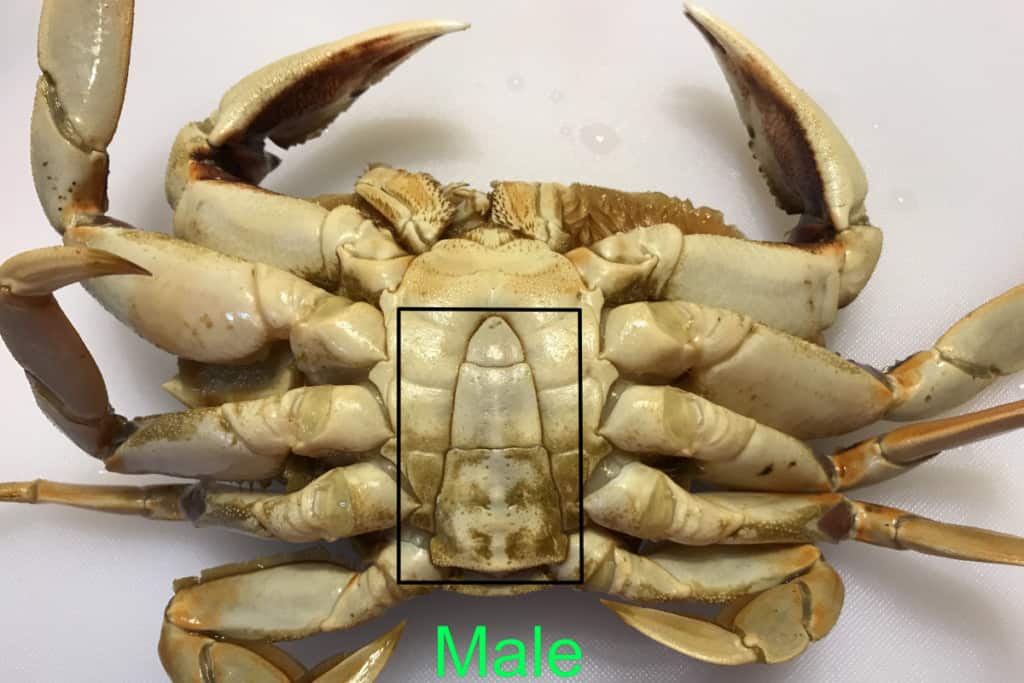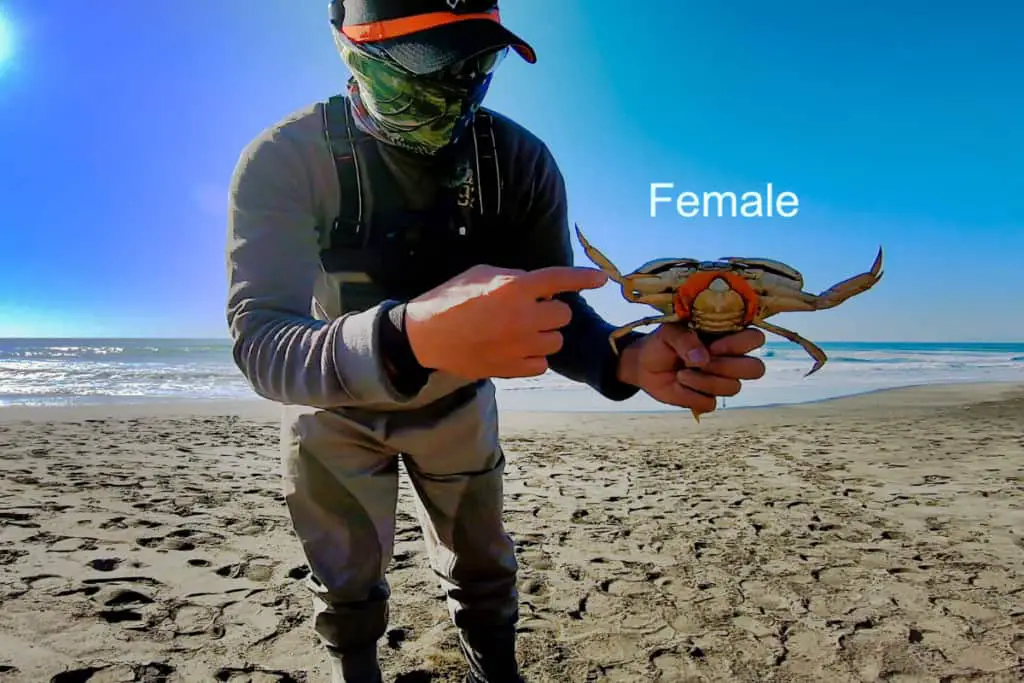On the west coast, you have a unique opportunity to catch Dungeness crab from the surf, unlike many other parts of the country. Specifically, in Northern California, Dungeness crab is plentiful (given that the weather has been treating them well throughout the year) and highly desired because they taste so good!
If you are wondering how to catch Dungeness crab from the surf? This guide will show you everything you need to know to catch them.
While adhering to California regulation, catching Dungeness crab from the surf can be accomplished with the proper rods, reels, lines, snares, and bait. Picking a sunny day with low wind and calm waters, Dungeness crab can be caught by casting your line far into the ocean, waiting for at least 10 – 15 minutes, and maintaining tension upon retrieval.
Crabbing for Dungeness crabs doesn’t require a ton of fishing gear, and if you’re in an area where these crabs live, they’re well worth the effort to catch them.
I’ve pulled together all you need to know about catching Dungeness crab from the surf so that you can be well informed and have greater success in catching them yourself.
Complete Beginners Guide to Crab Snaring
What follows is a complete beginner’s guide to get started snaring for crabs. While this guide is written specifically for Dungeness crabs, many of these crabbing tips (with the exclusion of the species-specific rules and regulations) can be used to catch many different kinds of crabs.
Rules and Regulation for Crab Snaring
Crabbing is an enjoyable fishing-adjacent sport, but it’s essential to keep in mind that like fishing, crabbing on the Pacific coast is regulated by the U.S. Fish and Wildlife Service. ![]()
While anglers don’t need a fishing license to crab for Dungeness crab off a public pier, they do need one for fishing from the surf, just as you would for any rod and reel.
Related Article: Is Dungeness Crab Safe To Eat? Why You Shouldn’t Eat Dungeness Crab. In this article, I broke down what to avoid when eating Dungeness crab and how to prepare it properly.
Here are the rules and regulations recreational fishers should abide by according to California law for Dungeness crab snaring:
When Does Crabbing Season Start?
The crabbing season in California runs from the first Saturday of November until June 30th![]() . If you are south of the Mendocino-Sonoma County border, the season is extended until July 30th if you are north of this border.
. If you are south of the Mendocino-Sonoma County border, the season is extended until July 30th if you are north of this border.
This is to protect the populations as Dungeness crab is limited as you head further south.
Catching Location:
As the previous regulation notes, the location has an impact on your ability to snare crabs. If you are in San Francisco, you are only allowed to harvest crabs west of the Golden Gate Bridge.
These limits are meant to maintain the health of the Dungeness crab species throughout the state of California.
Daily Limits and Measurements
In another effort to protect crab populations, there is a daily limit of 10 keepers![]() (crabs that are legal to keep) per fisherman. Each of the crabs must be a minimum of 5-¾ inches
(crabs that are legal to keep) per fisherman. Each of the crabs must be a minimum of 5-¾ inches![]() to be considered a keeper.
to be considered a keeper.
This measurement must be completed with a concave crab shell gauge and measured from the inside points of the shell across its back.
Gender Requirements
In the state of California, both male and female Dungeness crabs are allowed to be harvested as long as they are in accordance with the minimum size measurements.
Female crabs that are pregnant can be collected, but it is advised that you release them to encourage population growth for future harvests.
Snaring Equipment Requirements
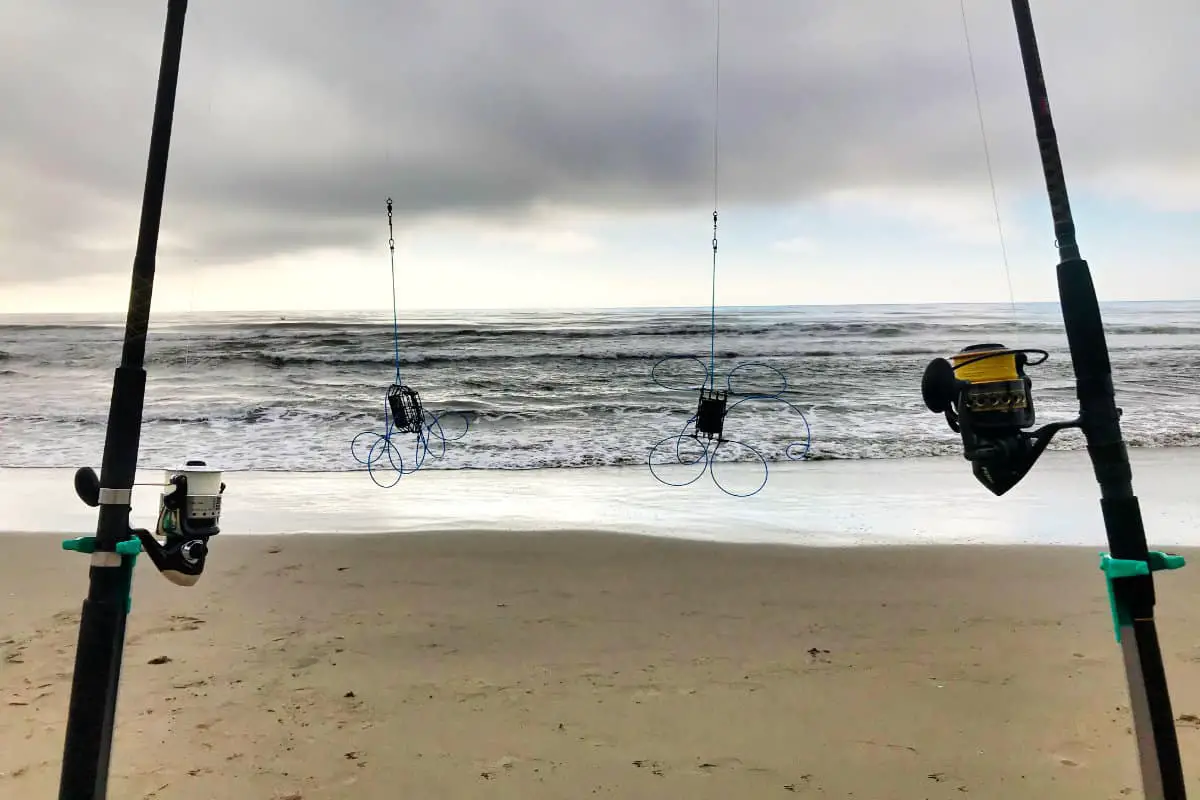
Crab snares are only allowed to have a maximum of six loops in the state of California, so you will need to cut away any extras if the one you purchase has more than six.
It is also legal to use hoop nets and crab pots to catch crab. You are not allowed to catch crab by hook and line, so if you want to go crabbing, you will have to purchase the proper equipment.
Fishing License
You must have a fishing license![]() if you’re 16 years old or older to snare Dungeness crab from the surf and along the shoreline. You can purchase these licenses for short-term or long-term use, depending on your needs.
if you’re 16 years old or older to snare Dungeness crab from the surf and along the shoreline. You can purchase these licenses for short-term or long-term use, depending on your needs.
If you are planning to fish on a public pier, a fishing license is not necessary. Anglers do not need a permit if they are positioned on a public dock or structure.
There are many close relatives to the Dungeness crab, so you will want to make sure you are snaring the right ones and that you are following all of these regulations.
If a state official stops you, they will likely look at your crab to ensure you are adhering to these rules. Make sure you always have your fishing license and your crab gauge with you at all times.
The fine for catching a crab that does not adhere to these standards is $1,000 for the first one. And an additional $100 for each unsuitable crab after that.
These strict rules and fines are in place to make sure you are practicing legal and safe crab snaring. You can purchase your fishing license here![]() .
.
What Tackle Equipment You Need for Crab Snaring?
Now that you are aware of the rules, you have to follow. You’ll want to set yourself up with the best equipment for a successful day of crab snaring.
My recommendations for equipment are designed with beginners in mind but can be used by all levels of anglers.
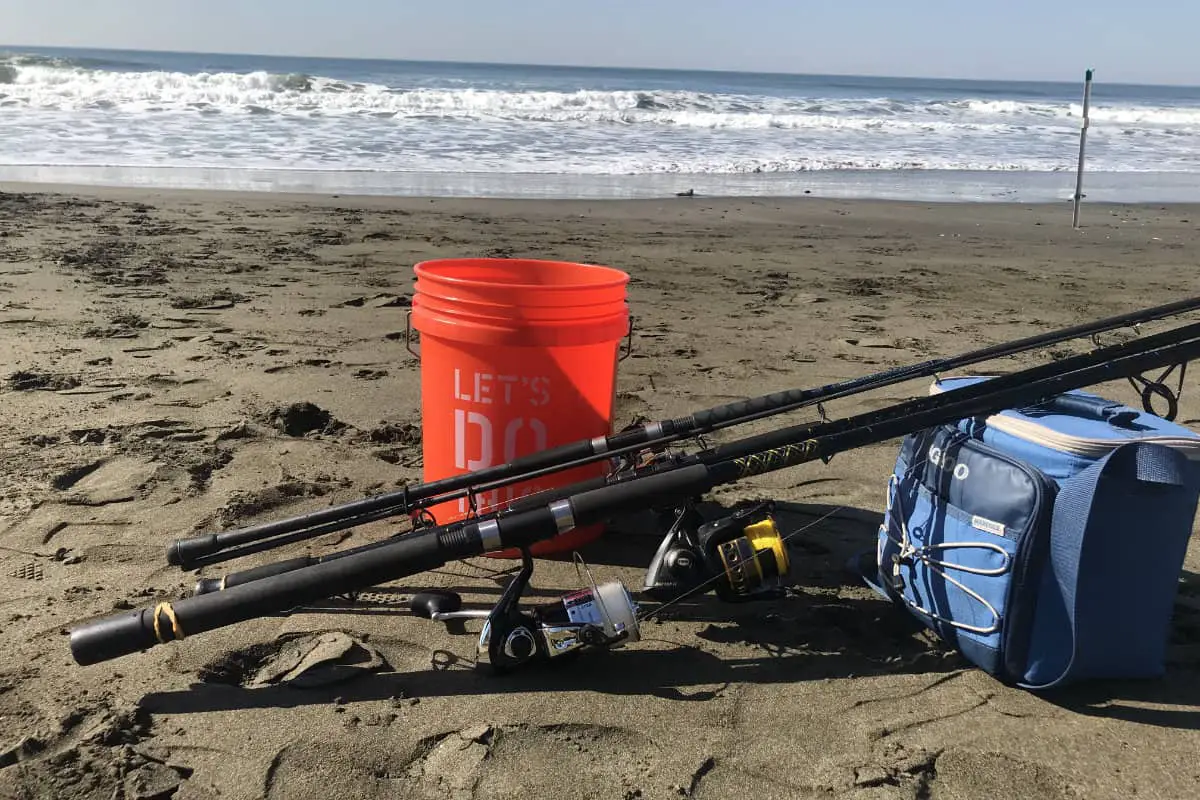
These are some essential items you should have with you when you go crab snaring:
- Fishing Rod
 (Medium-heavy – Heavy action, 10 – 12 ft)
(Medium-heavy – Heavy action, 10 – 12 ft) - Spinning Reel
 (At least 6000)
(At least 6000) - Mainline
 (50 braid line)
(50 braid line) - Snares

- Bait
- Bucket

- Crab measuring tool or crab gauge

- Weight
- Snap Swivel

- Rod Holder or Sand pike
- Fishing License
Looking at each of these items in greater detail, crab snaring is a rigorous activity that requires durable equipment. Often you are in areas that are not particularly calm, and this can put a lot of stress on your gear.
Opting for larger sizes and more heavy-duty pieces of equipment will serve you better over time.
Recommended Rods, Reels, and Lines for Crab Snaring
These three pieces of equipment are incredibly important because they are responsible for getting the crab from the water to you. These items need to be the most durable of any of the equipment that you will use.
Medium Heavy or Heavy Action Rod
I recommend using at least a 10-foot to 12-foot rod ![]() that is heavy or medium-heavy action rod because it is often more durable and more capable than lighter rods. You don’t risk snapping with bigger rods.
that is heavy or medium-heavy action rod because it is often more durable and more capable than lighter rods. You don’t risk snapping with bigger rods.
Saltwater Spinning Reel
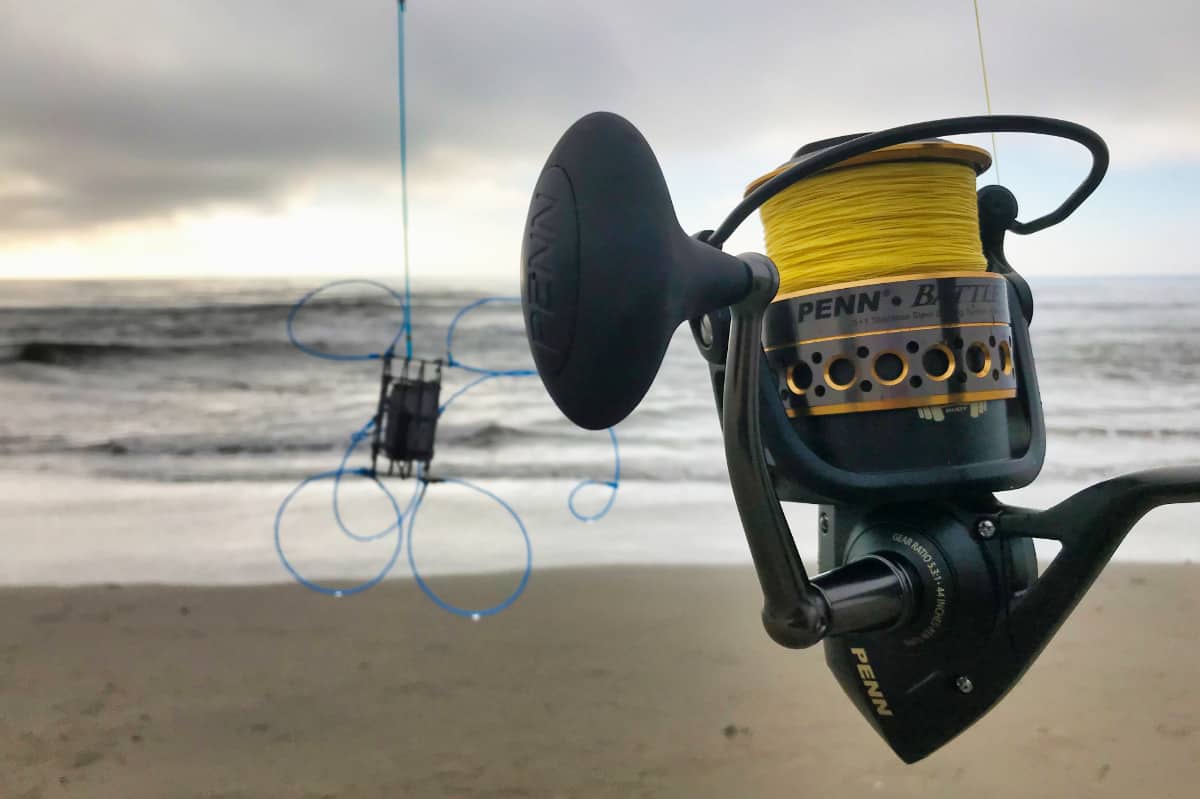
Spinning Reels![]() also come in different sizes and strengths. For crab snaring, I recommend using a 6,000 or 8,000 spinning reel
also come in different sizes and strengths. For crab snaring, I recommend using a 6,000 or 8,000 spinning reel![]() to handle the variability of the surf and allow you to bring back your line reliably (ideally with a crab attached).
to handle the variability of the surf and allow you to bring back your line reliably (ideally with a crab attached).
Braided Line
If you have gone with the durable options for your rod and reel, you’ll want to follow suit with your line. A thin line has a higher chance of snapping or losing your snare than one that is suited for rougher conditions and more substantial crab.
I recommend using a braided line![]() that can account for at least 40-50 pounds
that can account for at least 40-50 pounds![]() . This type of line increases your casting range and weight tolerance.
. This type of line increases your casting range and weight tolerance.
Another option is a monofilament line. When I was new to crabbing, I started with monofilament. Ask the local tackle shop in your area to set one up for you.
Snap Swivel
The purpose of the snap swivel![]() is useful to prevent your main line from twisting upon retrieval. Using this will also make your snare easier to take on and off the fishing line.
is useful to prevent your main line from twisting upon retrieval. Using this will also make your snare easier to take on and off the fishing line.
I prefer to use at least 78 lbs. or higher to make sure it can handle the load of my catch. You can always adjust depending on your needs.
Crabbing Snares
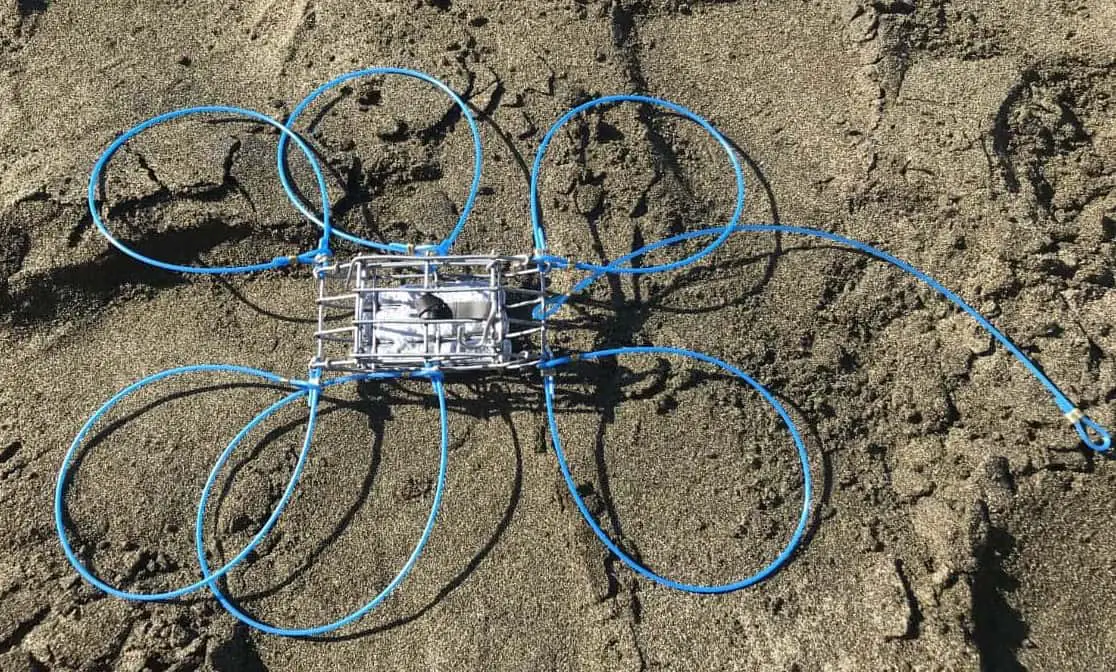
Snares are comprised of a small bait box and a maximum of six loops to tangle the crab. The best traps have these loops facing upward on the snare box for an optimal catch.
You can buy snare boxes from many fishing supplies, but they are also reasonably easy to make on your own.
There is no size limit for the loops used in a Dungeness crabbing snare, but the maximum number of snare loops that a crabbing snare can have is six. Crabs are not allowed to be taken by hand with a hook and line.
Essential Bait
Bait is also an essential consideration in snaring your crab. There are many options in choosing your Bait, but some that are known to be the most successful for catching crab include squid and mackerel.
Most frozen fish will do, and you can experiment as some days certain baits will work better than others. The key is to have enough Bait, so it does not escape the snare.
Weight or Additional Sinker
Although some snares have built-in weight on it, in rougher water conditions or a strong current, the snare will be more stable if you add weight. A stable snare will allow the crab to approach the traps more easily.
For stronger currents and waves, you will want to make sure that the snare box is weighted so that it is not easily moved by the waves allowing it to sit in one spot for optimal snaring.
Check this article to learn the different weights you can use for surf fishing.![]()
Sand Spike or Rod Holder
A sand spike or rod holder is a must-have for every crabbing trip. You need something to hold your rod while waiting for retrieval.
Holding a massive rod for an extended period is very tiring. So, don’t forget to bring this every time you hit the surf.
Buckets
Keeping Dungeness crab alive right up until you are going to eat them is the best way to preserve their freshness. You can keep them in a bucket![]() of saltwater to do this!
of saltwater to do this!
Depending on the conditions and the amount of crab you hope to catch, buckets can vary in size. A two-gallon bucket will work for two-three keepers while a five-gallon bucket![]() can hold up to ten.
can hold up to ten.
Smaller buckets are more comfortable to carry if you are in rockier conditions where it will be a bit more challenging to maneuver with heavy equipment.
Dungeness crabs burn through oxygen in the water quickly, so you don’t want to keep them in a plain bucket of water for an entire day.
Consider adding a Bubble Box, which provides more oxygen if they will spend several hours in the Bucket.
Crab Gauge or Measuring Tool
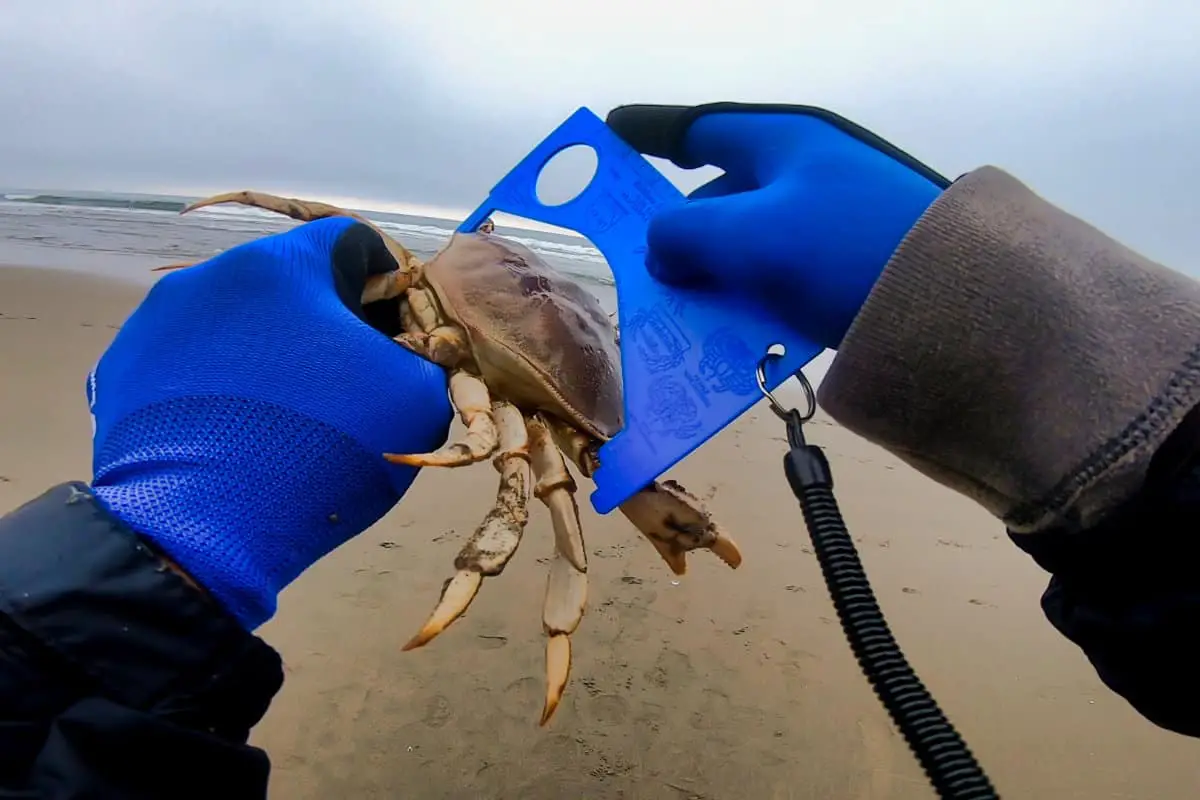
Because there is a minimum size limit on Dungeness crab, you’ll need to bring along something to make sure that the crab you haul in meets the five and three-quarters inch minimum size rule. Here’s my recommended gauge check it out on Amazon.
Fishing License
As we mentioned, you must have your valid fishing license and your crab measuring tool on you at all times.
These tools will help you ensure that you are adhering to necessary regulations and practicing proper fishing protocol.
Keep these items with your gear at all times, that way you won’t forget them when you head out.
Once you have these necessary supplies, you are ready to go to catch some Dungeness crabs.
Note: If you are pregnant or your wife is pregnant, please read this article![]() to learn what to avoid when eating Dungeness crab.
to learn what to avoid when eating Dungeness crab.
Guide and Techniques to Catch Dungeness Crabs
With the proper equipment and ideal conditions, you will also want to hone your technique. Properly casting your line can help to increase your success rate in snaring Dungeness crab.
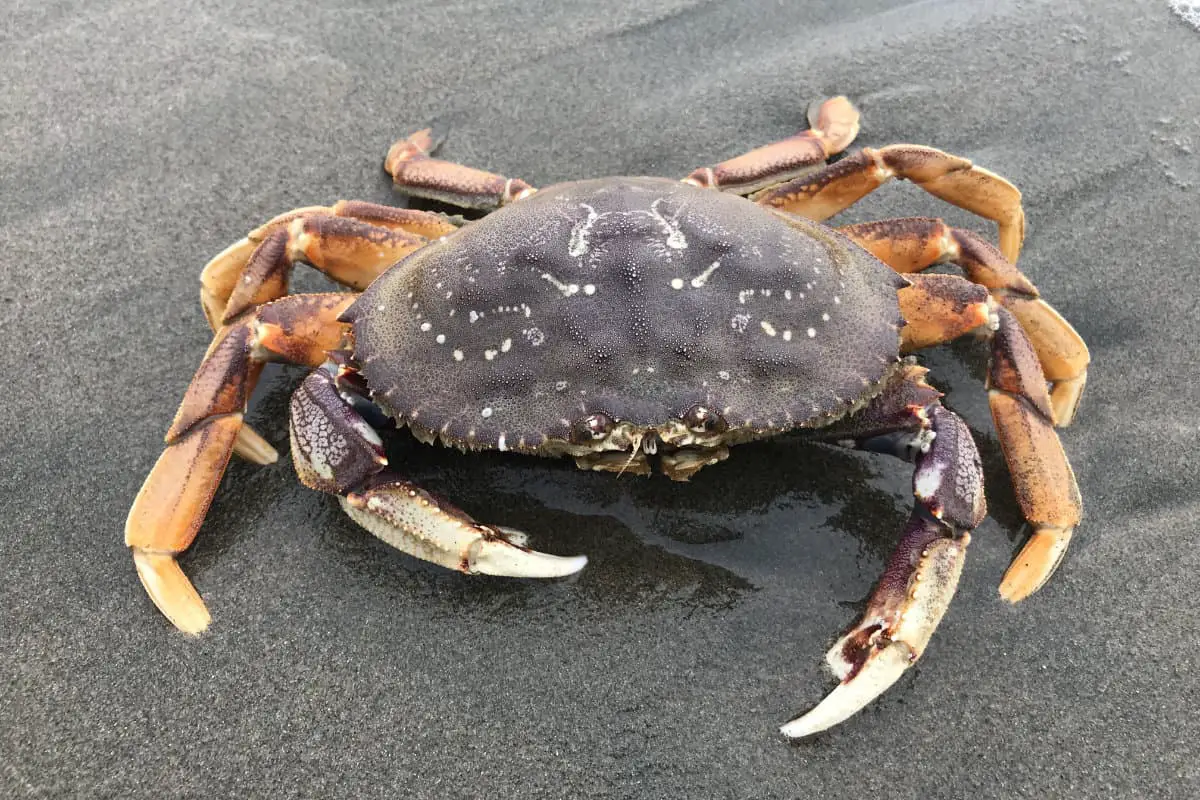
There are three main areas we will break down related to physically catching the crab:
- Casting the Snare
- Retrieving the Snare
- Time Spent Waiting
How to Cast Your Snares
If you are using a rod and reel, there are two primary ways to cast the snare: overhead and side-hand. Overhand is a simple approach but can be harder to control when the snare is heavier.
Side-hand often results in a longer cast and gives you more control in launching the snare.
To cast your snare.
- Hold the rod and the reel where it’s comfortable for you.
- Manually turn the bail up towards the rod.
- Then using your index finger takes the line and secures it against the rod.
- Then open the bail with the left hand, then locate your target as to where you want to cast.
When you have a heavier snare, try to let the weight bounce on the line before casting. And make sure you have enough distance between your rod tip down to the lure. You don’t want it to be too long, and you don’t want it to be too short.
Proper Way of Retrieving Your Snares
Retrieving the snare requires clean and straightforward techniques to keep crab and snares attached to your line.
The most important thing to keep in mind when recovering a snare is to maintain constant tension on the line.
You cannot jerk the line and give it slack after pulling as this can open the loops allowing the crab to escape.
The proper technique for retrieving the crab on the line is to:
1. Keep the rod tip horizontal and then pull the rod back into the air to create tension
2. Start reeling the line in, and you will maintain consistent tension
3. You can also move backward while reeling to help you remove the slack of your line
4. Continue this until you have retrieved the snare and attached crab
Larger waves can make it more difficult to maintain this tension if the crab starts to surf the waves, and you cannot keep up with reeling.
Always make sure to set your drag tight before setting the hook.
Tension is crucial to keep the snares tight and prevent them from loosening, which will release the crab.
How Much Time You Have to Wait Before Retrieving Your Snares?
I always wait at least 10-15 minutes before retrieving my snare. The deeper the crab digs into the Bait, the more likely it is to get tangled in your loops.
If you try and retrieve when you first get contact, the crab may slip out of the snare as it has not spent enough time working its way into the snare. Patience is key and leads to more secure holds on crabs within the snare.
However, if you feel a crab or some weight latching on, I would recommend retrieving your snare immediately before crabs steal your bait.
When is The Best Time to Catch Dungeness Crab?

You can snare crabs at any time in the designated season, but there are some ideal conditions in which you will find more success in snaring crab.
Weather Condition
Calm and sunny days are the best ones to go crab snaring. These conditions are not only great for catching the crabs, but they also make the entire experience more pleasant.
You should be checking your local weather conditions before going out to snare crab. In stormy or rough weather conditions, you will not likely be successful in catching crab at all.
Tide and Current
Having little variability in the tide and a weak current are ideal conditions for crab snaring. High or low tide is not as important as the range of tide during the day, as this is a reliable indicator of the strength of the current.
Stronger currents will make it more difficult for your line to stay in one place, often confusing the crab, which makes attracting them to your snares more challenging.
You should check the tide forecasts to determine the conditions for the day you will be crab snaring.
Stronger currents will not only make it more challenging to snare crab in the first place, but they also increase the risk of losing the crab or your snare when trying to retrieve the line.
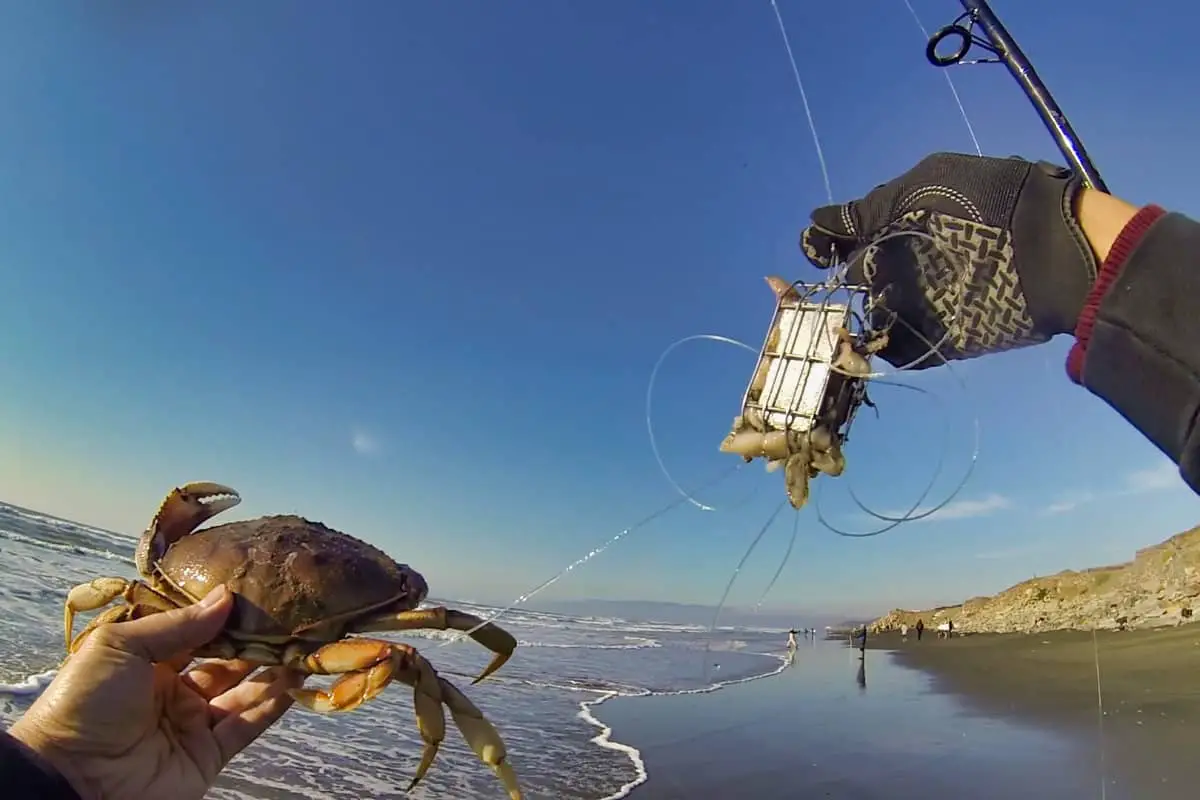
I always prefer going to the beach 2 – 3 hours before low tide, can increase your opportunity for success in catching the crab.
Wind Condition
Tying in with the quest for good weather, calm waters with low winds are the most ideal for crab snaring.
Trying to pull in a snared crab through more powerful waves places increased stress on the line and raises the chance of losing the crab altogether.
Low winds help to keep the snare in one spot as you wait for a crab to make its way over to your line.
Larger swells will also keep the crabs further from shore. You will have to get your line out farther to catch crabs in these conditions, which can be challenging.
Look for swells that are under five feet if possible; lower winds usually mean smaller swells.
Time of Day
Like most creatures that live in the surf zone, Dungeness crabs are dependent on the daily tides, and how the current, weather, and wind are behaving on any given day are going to be a significant indicator of how successful you are in your crabbing foray.
These times will vary based on your location, but looking at weather trends and tidal trends by the hour can help you make a better determination of when the water is at optimal conditions for crabbing in your area.
Dawn and dusk are usually the best times to go surf fishing, especially when you’re targeting striped bass. (Check my beginner’s guide on how to surf fish for striped bass.)
But, for crab snaring, I always prefer to go crabbing during the daytime, and at least 1 hour before the slack tide or outgoing tide, and crabbing until I get tired or catch more crabs.
Months of the Year
Dungeness crab season is open from November into June and July, but around spring and summertime, your chances of catching good crab are much slimmer.
The opening of the season is your best opportunity to catch bigger and more desirable Dungeness crabs, as this is when they are most plentiful. Most crabs (up to 80%) are scooped up by December.
What to Look For
Beyond the weather and water patterns on your day of crab snaring, the environmental conditions of the area you choose are also imperative to your success.
The best locations are sandy and flat. But that doesn’t guarantee your success of catching a crab. Sometimes you need to move and find them. Knowing how to read the structure of the beach![]() is a big advantage to be successful in surf fishing.
is a big advantage to be successful in surf fishing.
Areas with lots of rocks and plant-life can easily get caught in the snare and can cause you to lose the trap or damage the line. You might want to change spots if you encounter this kind of situation.
Want to learn how to find the best spot to catch more fish? Check this article here: How to find the best spot for surf fishing![]() .
.
Harvesting Dungeness Crab in California
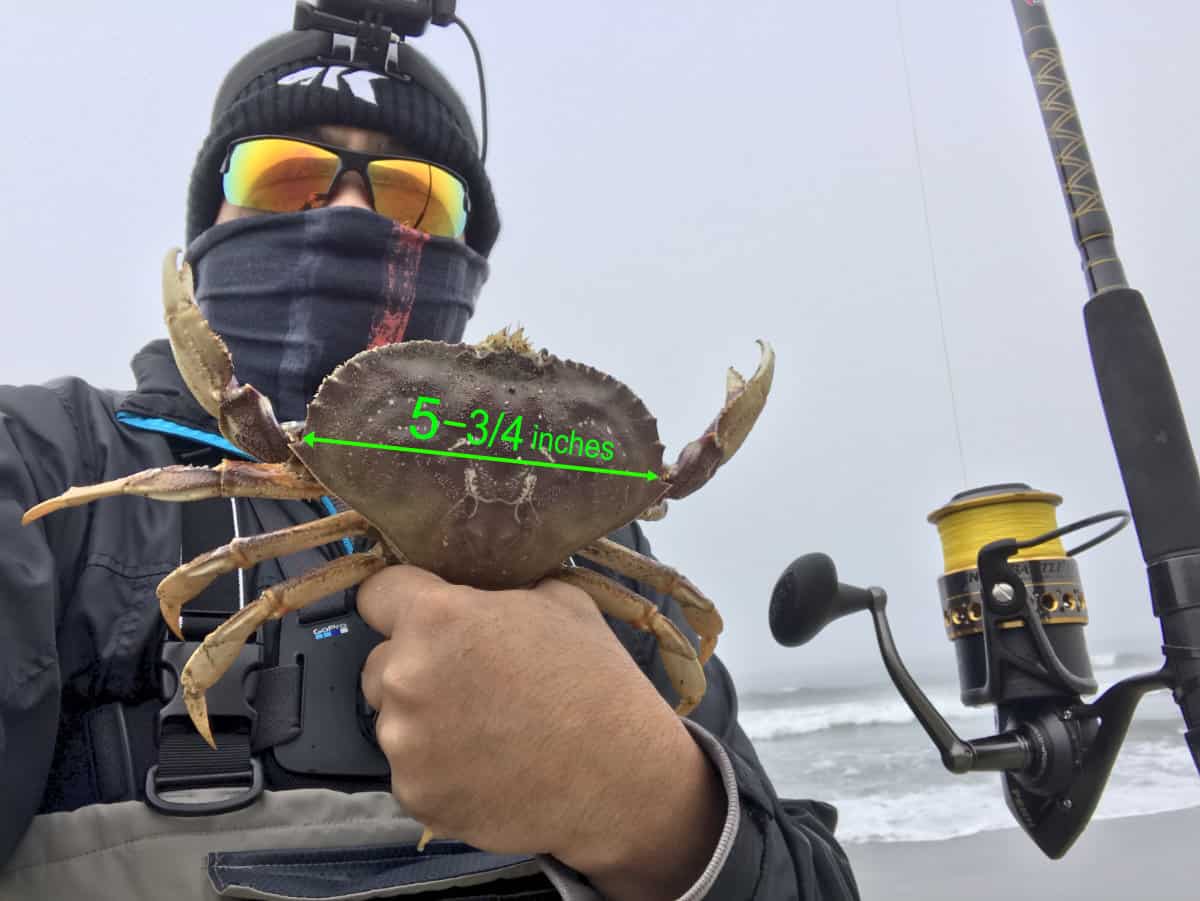
We have covered the rules and regulations for harvesting crab, but there are some additional details to discuss. You want to make sure you are crabbing safely and following these rules.
Correct Measurement Points
The exact sizing points are different in each state. In California, you measure the crab from its back to its sides (not including the points). This must measure a minimum of 5-¾” to be considered a keeper.
If you determine that the crab is not large enough to keep, it is also illegal to remove the legs or any other body part from the crab before you release it.
This not only makes it difficult to determine the size in the future but also leaves the crab defenseless against prey and makes it very hard for the crab to get food.
How to Identify Male and Female Dungeness Crab?
Luckily, determining the sex of a Dungeness crab![]() is relatively simple. If you flip a Dungeness crab onto its back, you will expose the abdominal shell plating.
is relatively simple. If you flip a Dungeness crab onto its back, you will expose the abdominal shell plating.
In female crabs, this plating has a rounded appearance, only tapering to a point near the crab’s head.
In a male Dungeness crab, however, this abdominal plating is much narrower and has an arrowhead shape.
Can You Keep Female Crabs?
Whether you can keep female Dungeness crabs or not depends on where you are catching them. California allows the harvest of female Dungeness crabs, though it is discouraged if the female crabs are pregnant.
Oregon states do not allow the harvest of female Dungeness crabs, nor does Washington State.
In California, where Dungeness females can be harvested, pregnant crabs are often still released even though their roe is considered a sweet and delicious delicacy.
You can tell that a Dungeness crab is pregnant by the presence of the bright orange eggs clustered on her underbelly.
How to Properly Hold Dungeness Crab Without Getting Pinched?
Many people are squeamish about picking up live crabs because they are afraid that the crab will latch onto them with its pincers and not let go.
Don’t’ t get me wrong that’s what a Dungeness crab wants to do when you drag it out of the ocean, but if you hold the crab correctly, you can avoid getting snipped or pinched.
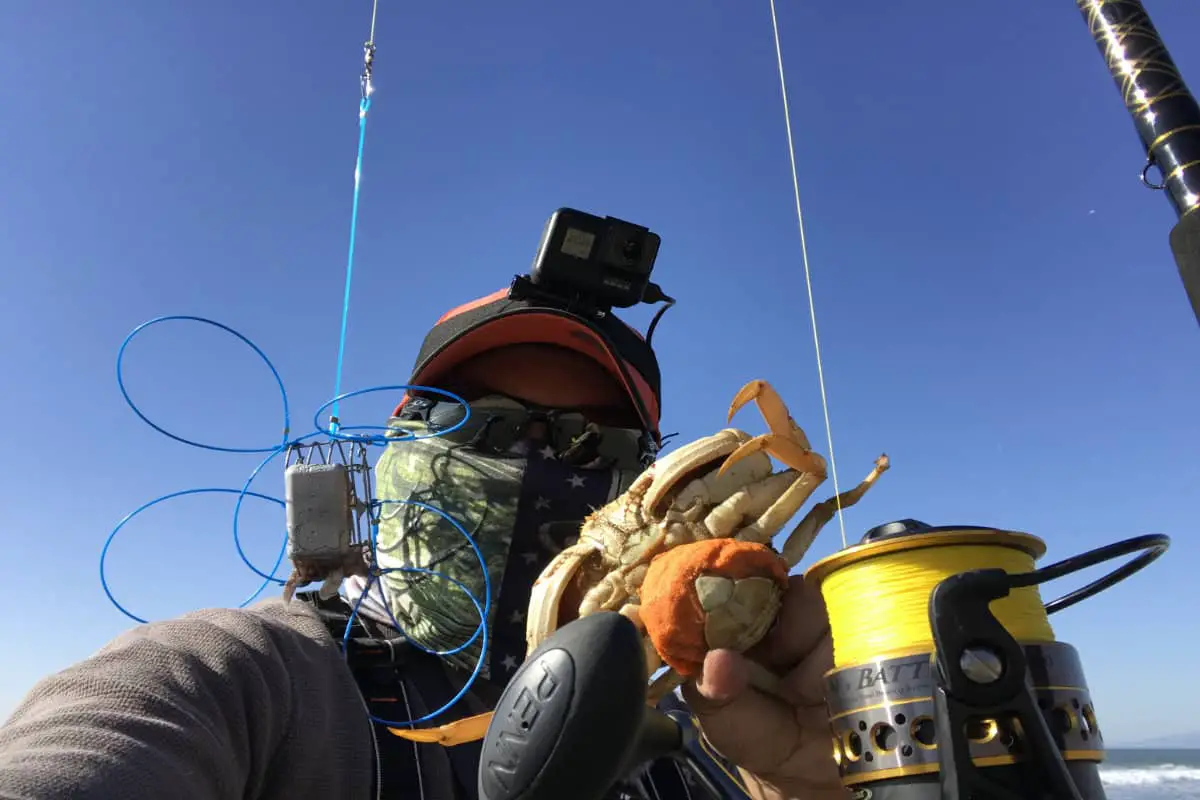
This hesitant behavior often leads to crabs being dropped and injured or damaged.
Picking up a Dungeness crab is simple—just follow this procedure:
- Lift the crab beneath its “armpits” behind its pincer arms and pick the crab up from the edges of its carapace (the tough outer shell on the back).
- You may need to hold the crab down with a stick or your shoe (gently!) to get a hold of it without it spinning around and striking you.
- Another way to pick up a Dungeness crab without touching it is to use crab catching tongs
 . These tongs allow you to hold the crab away from your body, so it doesn’t have a chance to pinch you.
. These tongs allow you to hold the crab away from your body, so it doesn’t have a chance to pinch you.
- Consider gloves: If you have access to heavy-duty waterproof gloves, getting pinched can be avoided or minimized. This may be helpful when the crab’s legs are caught in the loops and you need to free them.
- If you’re using your bare hands: try to grab the two legs on the back away from the pinchers. When you have the crab in hand, you can then transfer it to whatever cooler or bucket you’ re going to be using as a live well until you get the crab home.
Be sure to bring more than one cooler or one that is big enough to hold your crab limit. If you plan on catching more than five crabs, bring a bigger bucket, keeping more than five together in a small bucket or cooler increases the chance of mortality due to stress.
Related Article: Is Dungeness Crab Safe To Eat?![]()
Safety Precautions
In any type of fishing or activity related to the ocean, safety is a top priority. Here are some essential tips and precautions you should adhere to when crab snaring:
Use proper equipment: Unsafe equipment that is sharp or dangerous can bring harm to yourself and others. Make sure you are wearing the appropriate gear, including waders, shoes, and long pants and sleeves.
Maintain distance: Try to maintain a safe distance between you and other fishers if you are a beginner or they are. You can injure someone if you cast your line, and it doesn’t go exactly where you planned. Others may do the same thing if they are not experienced.
Do not go crabbing in lousy weather: Be hyper-aware of swells and tides when you are snaring in inclement weather. You can increase your chances of being pulled into the water or losing your equipment. This is especially true in rocky areas that are slick where there is an increased chance of slipping or falling.
If you go surf fishing alone, make sure that someone knows where you went and when you’ll be coming back: Since most surf fishing is done in low light conditions when there aren’t many other beachgoers around, it can be dangerous to go alone. You must go with another fisherman if you can. If you do go alone, however, make sure someone knows your plans just in case something unexpected happens.
Use some sunscreen and drink plenty of water: Even if the conditions are overcast or cold, the diffused sunlight reflected off the beach, and water can still cause a nasty sunburn. It’s also easy to lose track of how long you’ve been out crabbing and become dehydrated, so make sure you have drinkable water with you.
Disinfect if you do happen to get pinched by a crab. Crabs can carry some pretty gnarly bacteria on their shells and pincers that can lead to severe infections such as sepsis if left unchecked. So, if a crab does manage to pinch you and break the skin, be sure to sanitize the wound with antiseptic, then keep it wrapped and clean.
Summary
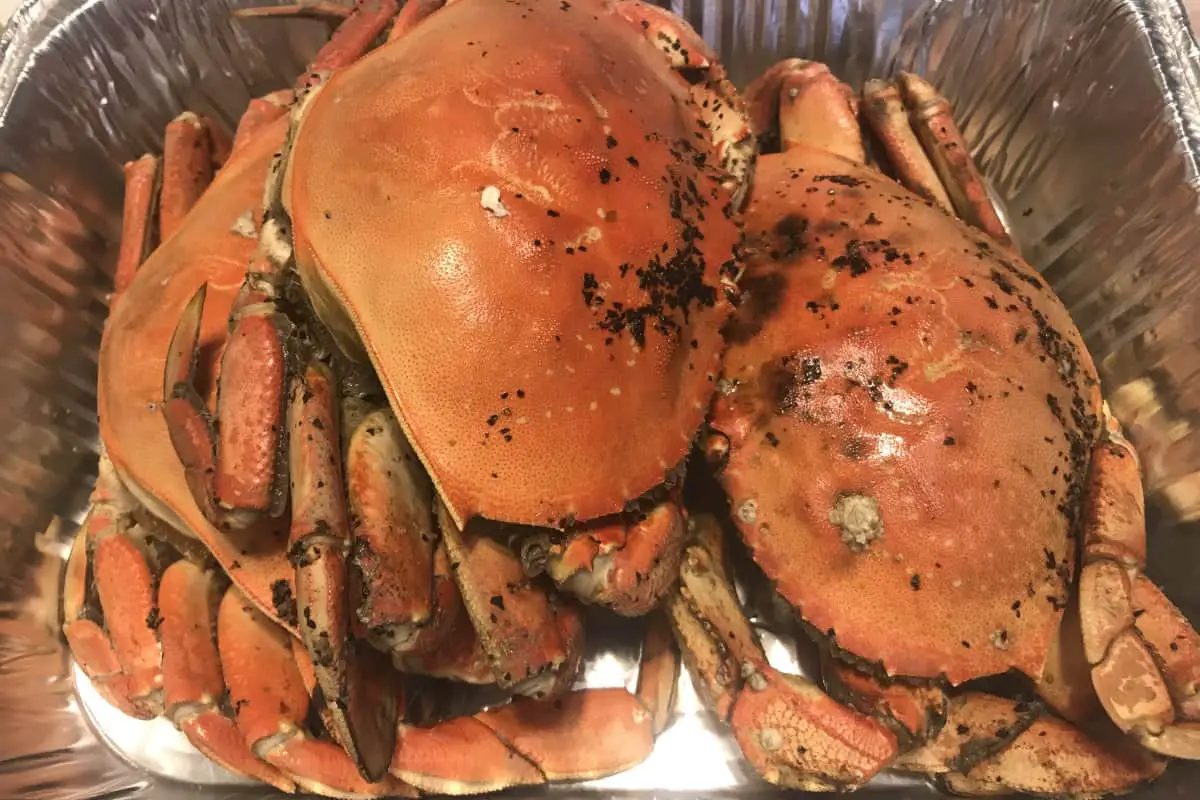
Crab snaring for Dungeness crab in California is an exciting and unique activity that you can’t experience in many other parts of the country. Northern California, in particular, is known for its great crab.
When practicing the proper technique and following California protocol![]() , you can bring home some of this excellent tasting crab for yourself.
, you can bring home some of this excellent tasting crab for yourself.
This complete guide is designed to make your life easier and give you all the necessary tools and knowledge to make your season of crab snaring successful.
Grab your equipment, practice your casting, and enjoy one of California’s freshest fishing opportunities!
Related article: Is Dungeness Crab Safe to Eat?![]()

